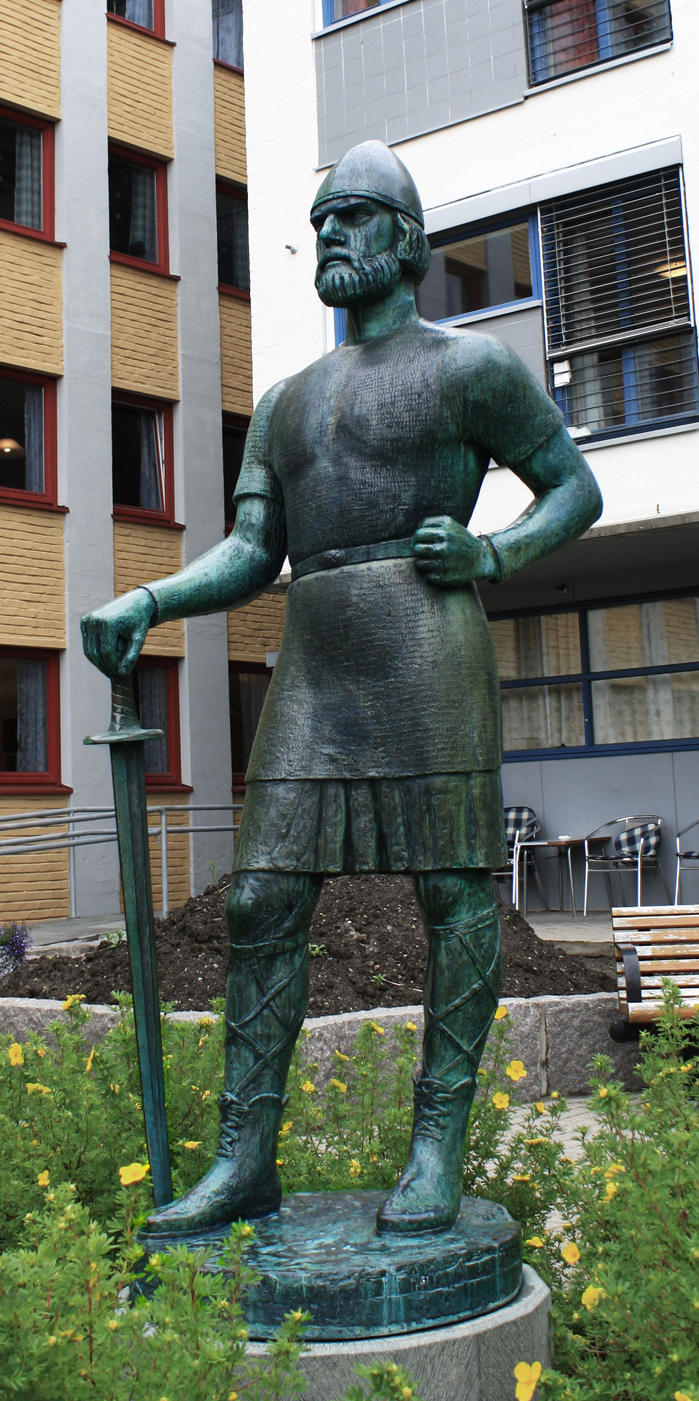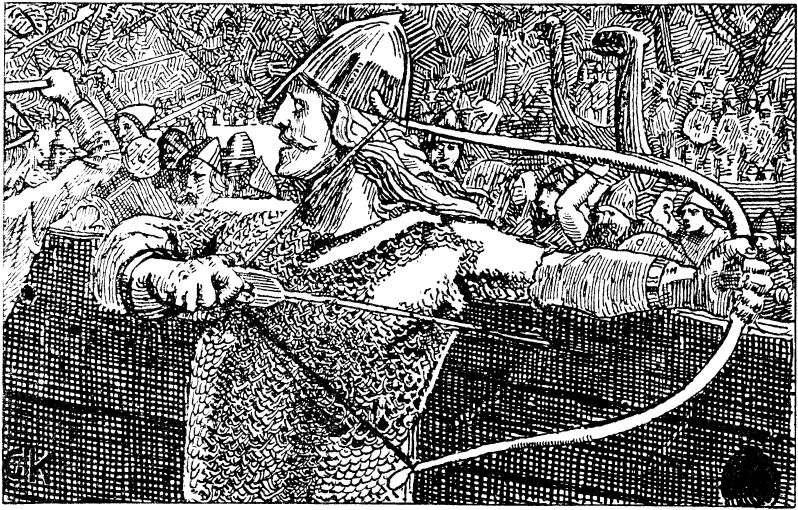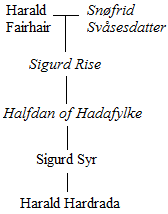|
Bergljot Håkonsdatter
Bergljot Håkonsdatter (b. ca. 990- d. ca 1055) was a Norwegian noble. Bergljot was the daughter of Haakon Sigurdsson (c. 937–995) Jarl of Lade and de facto ruler of Norway from about 975 until his death in 995. Bergljot was married to Einar Thambarskelfir (ca. 982-d. 1050) in a political marriage. They became the parents of Eindride Einarsson (d.1050). Her husband was one of the most powerful nobles in the country and served as royal advisor during the reign of King Magnus the Good (1035–1047). In 1046, Magnus made his uncle Harald Hardrada Harald Sigurdsson (; – 25 September 1066), also known as Harald III of Norway and given the epithet ''Hardrada'' in the sagas, was List of Norwegian monarchs, King of Norway from 1046 to 1066. He unsuccessfully claimed the Monarchy of Denma ... joint monarch of Norway. The following year, Magnus died and Harald became sole King of Norway. Subsequently, Einar began moving against the increasingly unpopular and tyrannical King H ... [...More Info...] [...Related Items...] OR: [Wikipedia] [Google] [Baidu] |
Haakon Sigurdsson
Haakon Sigurdsson ( , ; 937–995), known as Haakon Jarl (Old Norse: ''Hákon jarl''), was the '' de facto'' ruler of Norway from about 975 to 995. Sometimes he is styled as Haakon the Powerful (), though the '' Ágrip'' and '' Historia Norwegiæ'' give the less flattering name ''Hákon Illi'', that is, Haakon the Bad. Background Haakon was the son of Sigurd Haakonsson, Jarl of Lade and ruler of Trøndelag and Hålogaland. His mother was Bergljot Toresdatter, daughter of Tore Ragnvaldsson, Jarl of Møre. Adam of Bremen wrote that he was "of the stock of Ivar (either Ivar the Boneless or Ivar Vidfamne) and descended from a race of giants". In the sagas, Haakon claimed descent from the divine lineage of Sæming, son of Odin. The Hakon Jarl Runestones in Sweden may refer to him. Reign Haakon became '' jarl'' after his father was killed by King Harald Greycloak's men in 961. Haakon Jarl warred with King Harald for some time, until he was forced to flee to Denmark, whe ... [...More Info...] [...Related Items...] OR: [Wikipedia] [Google] [Baidu] |
Earls Of Lade
The Earls of Lade () were a dynasty of Norse '' jarls'' from Lade (Old Norse: ''Hlaðir''), who ruled what is now Trøndelag and Hålogaland from the 9th century to the 11th century. The seat of the Earls of Lade was at Lade Gaard, now located in the eastern parts of the city of Trondheim. The site is near the seaside of the Trondheimsfjord, which was an important waterway in the Viking Age. According to Snorri, King Harald I of Norway was a great commander but lacked a fleet. For that he was assisted by Håkon Grjotgardsson. In gratitude Harald made him the first earl of Lade. Notable Earls of Lade * Hákon Grjótgarðsson (c. 860–870 – c. 900–920), an ally and father-in-law of Harald Fairhair * Sigurðr Hákonarson (died 962), friend and advisor of Hákon the Good * Hákon Sigurðarson (c. 937–995), ruler of Norway from about 975 to 995 * Eiríkr Hákonarson (960s – 1020s), governor of the majority of Norway under Svein Forkbeard * Sveinn Hákonarso ... [...More Info...] [...Related Items...] OR: [Wikipedia] [Google] [Baidu] |
Einar Thambarskelfir
Einar Eindridesson Thambarskelfir (c. 980–c. 1050) (, ) was an influential Norwegian noble and politician during the 11th century. He headed the feudal lords in their opposition to Olaf Haraldsson. Several references are made to him in Snorri Sturluson's Heimskringla. His cognomen, ''Thambarskelfir'', has two strongly differing explanations. One is that it is derived from ', meaning "shaking bowstring". Thus, the name suggests a master of the longbow. The other is that it is derived from ', meaning "belly", and that it translates to "wobbly belly", surely an unflattering reflection of his physical build. Or it could be the “belly” of the bow. Background Einarr Thambarskelfir was the son of Eindride, a rich and influential farmer at the Viking Age political center of Melhus. Einar Thambarskelfir was a jarl and chieftain at Husaby, a farm in Skaun municipality, and a powerful warlord with his own army. He descended from the Earls of Lade, one of the dominant familie ... [...More Info...] [...Related Items...] OR: [Wikipedia] [Google] [Baidu] |
Magnus The Good
Magnus Olafsson (; Norwegian and Danish: ''Magnus Olavsson''; – 25 October 1047), better known as Magnus the Good (; Norwegian and Danish: ''Magnus den gode''), was King of Norway from 1035 and King of Denmark from 1042 until his death in 1047. Magnus was an illegitimate son of Saint Olaf, and fled with his mother Alfhild when his father was dethroned in 1028. He returned to Norway in 1035 and was crowned king at the age of 11. In 1042, he was also crowned king of Denmark. Magnus ruled the two countries until 1047, when he died under unclear circumstances. After his death, his kingdom was split between Harald Hardrada in Norway and Sweyn Estridsson in Denmark. Early life Magnus was an illegitimate son of King Olaf Haraldsson (later Saint Olaf) by his English concubine Alfhild, Carl Frederik Bricka, ''Dansk Biografisk Lexikon'', vol. XI aar – Müllner 1897p.44 originally a slave ( thrall) of Olaf's queen Astrid Olofsdotter. Born prematurely, the child was weak and u ... [...More Info...] [...Related Items...] OR: [Wikipedia] [Google] [Baidu] |
Harald Hardrada
Harald Sigurdsson (; – 25 September 1066), also known as Harald III of Norway and given the epithet ''Hardrada'' in the sagas, was List of Norwegian monarchs, King of Norway from 1046 to 1066. He unsuccessfully claimed the Monarchy of Denmark, Danish throne until 1064 and the List of English monarchs, English throne in 1066. Before becoming king, Harald spent 15 years in exile as a mercenary and military commander in Kievan Rus' and chief of the Varangian Guard in the Byzantine Empire. In his Gesta Hammaburgensis ecclesiae pontificum, chronicle, Adam of Bremen called him the "''Thunderbolt of the North''". In 1030, the fifteen-year-old Harald fought in the Battle of Stiklestad along-side his half-brother Saint Olaf, Olaf Haraldsson. Olaf sought to reclaim the Norwegian throne, which he had lost to Danish king Cnut two years previously. Olaf and Harald were defeated by forces loyal to Cnut, and Harald was forced into exile to Kievan Rus'. Thereafter, he was in the army of Gra ... [...More Info...] [...Related Items...] OR: [Wikipedia] [Google] [Baidu] |
990s Births
99 may refer to: * 99 (number) * one of the years 99 BC, AD 99, 1999, 2099, etc. Art, entertainment, and media Film, television and radio * 99 (1918 film), ''99'' (1918 film), a Hungarian film * 99 (2009 film), ''99'' (2009 film), an Indian Hindi film * 99 (2019 film), ''99'' (2019 film), an Indian Kannada film * The 99 (TV series), ''The 99'' (TV series), a 2011–2012 animated series * WNNX (99X), classic "Rock 100.5" FM, in Atlanta, Georgia * 99 (Brooklyn Nine-Nine), 99 (''Brooklyn Nine-Nine''), an episode of ''Brooklyn Nine-Nine'' * 99, a List of Star Wars characters#99 "Ninety-Nine", character from ''Star Wars: The Clone Wars'' ** Clone Force 99, also called "The Bad Batch" and the eponymous animated series (named after the character in-universe) Games * '''99: The Last War'', a renamed version of the arcade game ''Repulse'' * Ninety-nine (addition card game), a simple card game where players drop out if forced to bring the total above 99 * Ninety-nine (trick-taking card game ... [...More Info...] [...Related Items...] OR: [Wikipedia] [Google] [Baidu] |
1050s Deaths
1 (one, unit, unity) is a number, numeral, and glyph. It is the first and smallest positive integer of the infinite sequence of natural numbers. This fundamental property has led to its unique uses in other fields, ranging from science to sports, where it commonly denotes the first, leading, or top thing in a group. 1 is the unit of counting or measurement, a determiner for singular nouns, and a gender-neutral pronoun. Historically, the representation of 1 evolved from ancient Sumerian and Babylonian symbols to the modern Arabic numeral. In mathematics, 1 is the multiplicative identity, meaning that any number multiplied by 1 equals the same number. 1 is by convention not considered a prime number. In digital technology, 1 represents the "on" state in binary code, the foundation of computing. Philosophically, 1 symbolizes the ultimate reality or source of existence in various traditions. In mathematics The number 1 is the first natural number after 0. Each natural numb ... [...More Info...] [...Related Items...] OR: [Wikipedia] [Google] [Baidu] |
11th-century Norwegian Nobility
The 11th century is the period from 1001 (represented by the Roman numerals MI) through 1100 (MC) in accordance with the Julian calendar, and the 1st century of the 2nd millennium. In the history of Europe, this period is considered the early part of the High Middle Ages. There was, after a brief ascendancy, a sudden decline of Byzantine power and a rise of Norman domination over much of Europe, along with the prominent role in Europe of notably influential popes. Christendom experienced a formal schism in this century which had been developing over previous centuries between the Latin West and Byzantine East, causing a split in its two largest denominations to this day: Roman Catholicism and Eastern Orthodoxy. In Song dynasty China and the classical Islamic world, this century marked the high point for both classical Chinese civilization, science and technology, and classical Islamic science, philosophy, technology and literature. Rival political factions at the Song dynasty ... [...More Info...] [...Related Items...] OR: [Wikipedia] [Google] [Baidu] |





